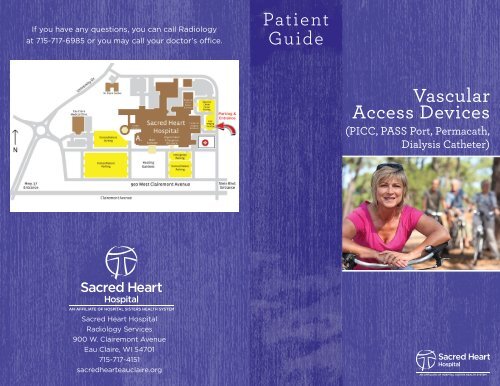Vascular Access Devices - Sacred Heart Hospital
Vascular Access Devices - Sacred Heart Hospital
Vascular Access Devices - Sacred Heart Hospital
Create successful ePaper yourself
Turn your PDF publications into a flip-book with our unique Google optimized e-Paper software.
If you have any questions, you can call Radiology<br />
at 715-717-6985 or you may call your doctor’s office.<br />
Patient<br />
Guide<br />
<strong>Vascular</strong><br />
<strong>Access</strong> <strong>Devices</strong><br />
(PICC, PASS Port, Permacath,<br />
Dialysis Catheter)<br />
<strong>Sacred</strong> <strong>Heart</strong> <strong>Hospital</strong><br />
Radiology Services<br />
900 W. Clairemont Avenue<br />
Eau Claire, WI 54701<br />
715-717-4151<br />
sacredhearteauclaire.org
<strong>Vascular</strong> <strong>Access</strong> <strong>Devices</strong><br />
A flexible thin plastic tube (catheter) will be put into a vein to<br />
provide a painless way to deliver medicines or nutrition, and draw<br />
blood. The type of catheter put in depends on what the catheter<br />
will be used for, and how long it will be needed.<br />
Following are the major types of vascular access catheters:<br />
• PICC line (peripherally inserted central catheter) is a catheter<br />
that goes from an arm vein into the largest vein near the heart.<br />
It is usually used for a few weeks, but can be used for a few<br />
months if needed.<br />
• Tunneled Catheter Central line has a cuff that supports tissue<br />
growth that will help hold it in place in the body. It can be used<br />
for a longer period of time.<br />
• Implantable Port catheter is a catheter attached to a small<br />
reservoir, which is put under the skin in the upper arm or the chest.<br />
It is used for chemotherapy and blood draws.<br />
Following are the major types of dialysis catheters:<br />
• Non-tunneled dialysis catheters are put in a large, more central<br />
vein, like the jugular vein in the neck or the femoral vein in the<br />
groin. These catheters are used when short term dialysis is needed.<br />
• Tunneled Dialysis Catheters has a cuff that supports tissue growth<br />
that will help hold it in place in the body. These catheters are needed<br />
for long term dialysis but are not limited to the use of dialysis.<br />
Before the Procedure<br />
Depending on the type of catheter is put in, you may or may not<br />
have something to eat or drink up to 4 hours before putting in the<br />
catheter. Ask your doctor if you can eat and drink before the<br />
procedure.<br />
For tunneled catheters and port catheters, blood thinning medicines<br />
like Aspirin, Coumadin (Warfarin) or Plavix should be discussed with<br />
your doctor. When possible, these medicines should not be taken for<br />
5-7 days before your procedure. You may take your other medicines<br />
with a sip of water unless told not to by your doctor.<br />
When you arrive, the procedure will be explained to you. You can<br />
ask any questions you have about the procedure, its risks, or how<br />
it will be done. Once your questions have been answered, you will<br />
be asked to sign a consent form.<br />
Depending on the type of catheter placed you maybe offered<br />
medicine for your comfort.<br />
During the Procedure<br />
These procedures are often done on an outpatient basis, so you will<br />
not have to stay overnight in the hospital.<br />
You will lie on your back on a special table. The area of the body where<br />
the catheter is to be put in (usually the neck, upper chest or upper<br />
arms) will be shaved, cleaned, and covered with a surgical drape.<br />
Depending on the type of catheter put in, a Registered Nurse may<br />
be with you during the procedure. The nurse may monitor your<br />
blood pressure and other vital signs.<br />
The person doing the procedure (radiologist) will use a special<br />
machine (ultrasound) to find a vein. The area will be numbed with<br />
medicine and a very small nick will be made in the skin where the<br />
catheter will be put in. A special x-ray machine will be used to put<br />
the catheter in the right place. Depending upon the type of catheter<br />
put in, a second area will be numbed, and you may feel some pressure<br />
or brief pain if a tunnel is created or a reservoir is placed, as<br />
with a port. Incisions are closed with stitches that dissolve, surgical<br />
glue and/or special tape.<br />
The procedure is usually done within 30-60 minutes.<br />
After the Procedure<br />
You should avoid hard, physical activity or lifting heavy objects with<br />
the arm that has the catheter. Never pull on the catheter tails, and do<br />
not get them caught on things like clothing.<br />
The incision/catheter site will be sore for 1-2 days. Bruising around<br />
the catheter is also normal. A small amount of bleeding from the site<br />
in the first 24 hours is also normal.<br />
You will receive home care instructions for the care of your catheter.

















